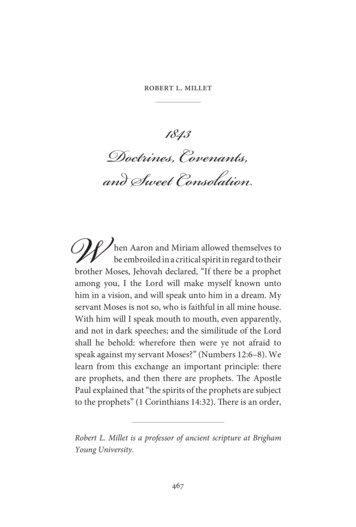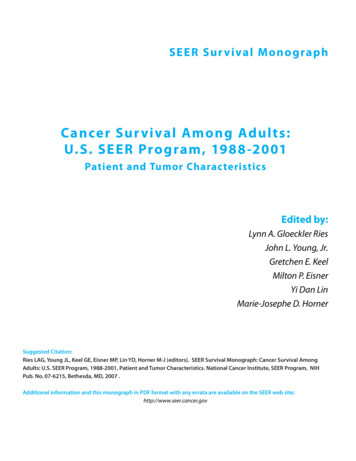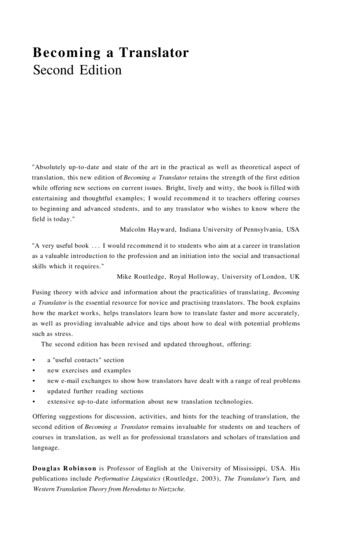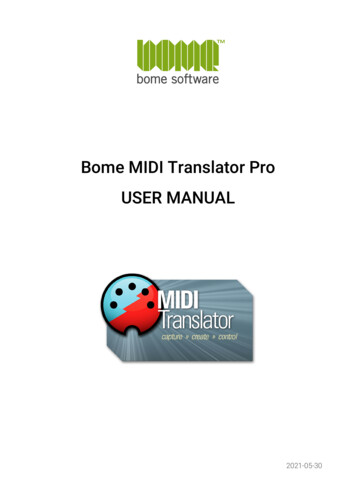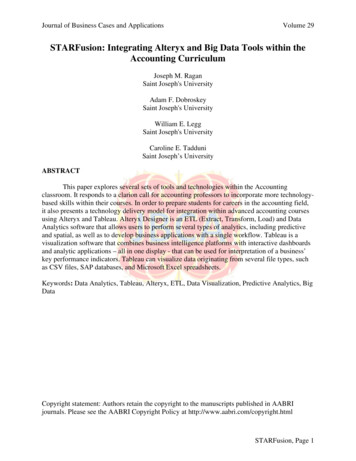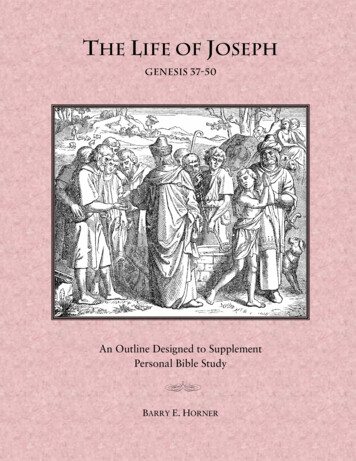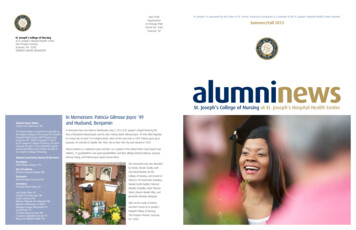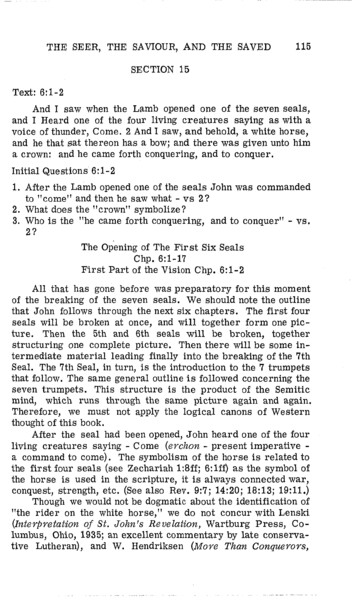
Transcription
salt lake city messengerEditor: Sandra TannerJune 2021Issue 135Utah Lighthouse Ministry1358 S. West TempleSalt Lake City, UT 84115www.utlm.orgJoseph Smith —Seer and Translator?“thou shalt be called a seer, a translator,.of Jesus Christ”(Doctrine and Covenants 21:1)Othe gold plates [to translate them]. And there’s so much inn April 6, 1830, the day Joseph Smith foundedthe Book of Mormon that comes out of the 19th centurythe Church of Christ, later renamed The Churchthat there’s a question of whether or not the text is anof Jesus Christ of Latter-day Saints, he receivedexact transcription of Nephi’s and Mormon’s words, or ifa revelation designating himself as “a seer, a translator, ait has been reshaped by inspiration to be more suitable forprophet, an apostle.” The terms prophet and apostle areus, a kind of an expansion or elucidation of the Nephitegenerally understood in LDS circles. But what is meantrecord for our times. I have no idea how that might haveby seer and translator? Does divine translation result inworked or whether that’s true. But there are just too manythe same message that scholars, taking a specific text fromscholars now, faithful church scholars, who find 19thone language and rendering itcentury material in that text. Thatin another, would arrive at? Ifremains a little bit of a mystery, justhow it came to be.2not, how are we to understand“translate” in Smith’s writings?Years of research have led toTraditionally the LDSseveraltheories of how JosephChurch has taught that the BookSmithproducedhis scriptures.of Mormon is a literal translationThese can be broadly put intoof an actual record, inscribedfour categories: (1) the literalon gold plates, recountingintellectualpreserve.orgtranslation, or “tight control,”God’s dealings with the peopletheory, where Smith dictated theoccupying America hundredsJoseph Smith dictating Book of MormonEnglish text he read on his seerof years before the arrival ofstone, which in turn was the Lord’s translation of whatthe Europeans. However, extensive research shows thepresence of nineteenth-century ideas and sources, such aswas recorded on the ancient plates;3 (2) the expanded text1the King James Version (KJV) of the Bible, in the book.theory, where Smith expanded the message of the ancientThis is causing some LDS scholars to redefine the wordrecord with current concepts and Bible quotes;4 (3) thetranslation to mean revealed text. For example, Richardrevelatory theory, where the dictated text is more theBushman, author of Joseph Smith: Rough Stone Rolling,result of inspiration, meditation and influences of the dayresponded in an interview:The Book of Mormon is a problem right now. It’s sobaffling to so many that Joseph was not even looking at1 Richard S. Van Wagoner, Natural Born Seer: JosephSmith, American Prophet, 1805-1830, (Salt Lake City: Smith-PettitFoundation, 2016) pp. 375-422. Also, Dan Vogel, Joseph Smithand the Making of a Prophet, (Salt Lake City: Signature Books,2004); B. H. Roberts, Studies of the Book of Mormon, (Salt LakeCity: Signature Books, 1992); William L. Davis, Visions in aSeer Stone, (University of North Carolina Press, 2020); Wesley P.Walters, Use of the Old Testament in the Book of Mormon, (SaltLake City: Utah Lighthouse Ministry, 1990); Jerald and SandraTanner, Joseph Smith’s Plagiarism of the Bible in the Book ofMormon, (Salt Lake City: Utah Lighthouse Ministry, 2010).2 Peggy Stack, “What you may not know about Mormonhistorian Richard Bushman — for one, he was agnostic when hewent on his mission,” (Salt Lake Tribune, Dec. 31, 2020). c-believer/3 Michael Hubbard Mackay and Nicholas J. Frederick,Joseph Smith’s Seer Stones, (Provo: BYU Press, 2016), p. 46. Alsosee Ulisses Soares, “The Coming Forth of the Book of Mormon,”April Conference, (2020). conference/2020/04/23soares?lang eng4 Mackay and Frederick, Joseph Smith’s Seer Stones, p.47. Also, Blake T. Ostler, “The Book of Mormon as a ModernExpansion of an Ancient Source,” (Dialogue: A Journal ofMormon Thought, Spring 1987); /sbi/articles/Dialogue V20N01 68.pdf
2salt lake city messengerthan actually translating an ancient record into English,sometimes referred to as the catalyst theory;5 (4) andthe naturalistic (fiction) theory where no ancient text isneeded, only the creative mind of the storyteller coupledwith religious issues of the day and current events.6These theories would help explain why Smith neverlooked at the ancient plates during his dictation. However,only the first theory fits the earliest accounts of Smith’stranslation efforts, with Smith simply reading the Godgiven English translation off his seer stone to scribes.In recent speeches and articles the top leadership of theLDS Church seem to be holding to the literal methodwhile many of its scholars seem to be looking more toan expanded text or the revelatory theory.7Book of Mormon Translation EssayIn 2013 the LDS Church released several essaysaddressing difficult issues in their history.8 One of thesearticles, “The Book of Mormon Translation,” discussesthe method used by Joseph Smith to render the Bookof Mormon into English.9 In this article we read “Theangel charged Joseph Smith to translate the book fromthe ancient language in which it was written.” ThusSmith is declared to be in possession of an actual recordthat is translatable.The article then proceeds to build a case of Smithas an uneducated man incapable of inventing such acomplicated story, thereby implying that it must be what itclaims to be, a God-given translation from an ancient text.The article asserts that Smith was untrained in languagesthus the translation was accomplished through the use ofdivinely prepared instruments called “interpreters” (largespectacles with crystal lenses preserved with the plates)and “seer stones” (magic rocks found in the ground byJoseph Smith).5 John Dehlin, “Why the Catalyst Theory is Dead on Arrival,(August 16, 2020), ry-is-dead-on-arrival/6 Fawn M. Brodie, No Man Knows My History, (AlfredA. Knopf, 1971), chapters 4 and 5. For an LDS evaluation of thevarious fiction theories see planations-origin-book-mormon-longitudinal-study.7 John-Charles Duffy, “The ‘Book of Mormon Translation’Essay in Historical Context,” The LDS Gospel Topics Series: AScholarly Engagement, edited by Matthew L. Harris and Newell G.Bringhurst, (Salt Lake City: Signature Books, 2020), pp. 100-122.8 Gospel Topics Essays, online at ospel-topics-essays/essays?lang eng9 Gospel Topics Essays, “Book of Mormon ranslation?lang engIssue 135We read further that “by looking through these, hewas able to read in English, the reformed Egyptiancharacters, which were engraven on the plates.” Thisclaim of dictating the English text as it appeared on theinterpreters or stone would certainly demand a Godgiven translation from one language to another, whichwould preclude Smith expanding the text.To emphasize the book’s historicity and underscoreSmith’s limited education and inability to composesuch a book the essay quotes Emma Smith, Joseph’swife, saying that he “could neither write nor dictate acoherent and well-worded letter, let alone dictate a booklike the Book of Mormon.” However, the inaccuracy ofthis statement is seen when we examine one of Smith’sletters written in 1829:Respected sir I would in form you that I arrivedat home on sunday morning the 4th. after having aprosperous journy, and found all well the people areall friendly to us except a few who are in oppositionto evry thing unless it is something that is axactly likethemselves and two of our most formadable persacutorsare now under censure and are cited to a tryal trial in thechurch for crimes which if true are worse than all theGold Book business. we do not rejoice in the affliction ofour enimies but we shall be glad to have truth prevail[.]there begins to be a great call for our books in this countrythe minds of the people are very much excited when theyfind that there is a copy right obtained and that there isreally books about to be printed.10While there are several misspelled words thedocument demonstrates that Joseph Smith could writea “coherent and well-worded letter,” thus showing thatEmma was simply trying to bolster the idea that Josephwas too uneducated to have composed the Book ofMormon. Also, Joseph himself wrote in 1832 that hestudied the Bible from the age of 1211 and his mothersaid he entertained the family in the evenings with storiesof the Native Americans.12 Young Joseph, according toOrsamus Turner, attended the local Methodist campmeetings, becoming a “very passible exhorter at eveningmeetings.” Turner also recalled that Joseph was involvedin the “juvenile debating club.”13 These activities show10 The Joseph Smith Papers, “Letter of Joseph Smithto Oliver Cowdery,” (October 22, 1829), cript.11 The Joseph Smith Papers, “Joseph Smith’s 1832 -summary/history-circasummer-1832/212 Lavina Fielding Anderson, ed., Lucy’s Book: A CriticalEdition of Lucy Mack Smith’s Family Memoir, (Salt Lake City:Signature Books, 2001), p. 345.13 H. Michael Marquardt, The Rise of Mormonism: 18161844, second edition, (Xulon Press, 2013), pp. 30-31.
Issue 135salt lake city messengerhe had an active mind, was a reader, and could composehis thoughts. In addition, one only needs to look at hisrevelations during and after writing the Book of Mormonto see his ability to dictate his thoughts to a scribe.143Dowsing with a rod.In the BeginningJoseph Smith spent his teen years in western NewYork, in an area often referred to as the burnt-over district,well-known for numerous religious revivals and spiritualexcitement. While his parents were religious, they werenot members of any particular church. However, duringan 1824–25 revival in Palmyra, New York, Joseph’smother, sister and two brothers joined the PresbyterianChurch. His father, Joseph Smith Sr., refused to affiliatewith any denomination and only attended one or two ofthe local revival meetings. Joseph Jr. studied the Biblefrom the age of twelve, attended the revivals often andevidently favored the Methodists.15In the 1820’s many people, including the Smiths,believed in magical stones, like crystal balls, and diviningrods that allowed the owner to discover the location ofburied treasures, metal or water. For instance, the WayneSentinel, published in Joseph Smith’s neighborhood,reprinted the following from the Windsor (Vermont)Journal:Money digging.—We are sorry to observe even inthis enlightened age, so prevalent a disposition to creditthe accounts of the Marvellous. Even the frightful storiesof money being hid under the surface of the earth, andenchanted by the Devil or Robert Kidd, are receivedby many of our respectable fellow citizens as truths. . . .A respectable gentleman in Tunbridge, was informed bymeans of a dream, that a chest of money was buriedon a small island. . . . After having been directed by themineral rod where to search for the money . . . he andhis laborers came . . . upon a chest of gold . . . the chestmoved off through the mud, and has not been seen orheard of since.16Oliver Cowdery, who acted as scribe for Smith14 For further information on Joseph Smith’s schooling,see “Reassessing Joseph Smith Jr’s Formal Education,” byWilliam Davis, (Dialogue: A Journal of Mormon Thought,Winter 2016, v. 49, no. 4): p. 112; ng-joseph-smith-jr-s-formal-education/?fbclid 1DIpWQWv9415 Grant H. Palmer, “Joseph Smith, Captain Kidd, Cumorah,and Moroni,” (John Whitmer Historical Journal, Vol. 34, No. 1):pp. 50-57; also Marquardt, Rise of Mormonism, pp. 24-27.16 Wayne Sentinel, Palmyra, New York, (February 16, 1825):p. 1. 1825-0216/ed-1/seq-1/during most of the Book ofMormon dictation, evidentlyclaimed the gift of working with adivining rod. In the 1833 Book ofCommandments, section seven,his gift is called “the gift of working with the rod” and“rod of nature” which works “in your hands, for it is thework of God.” But this section was rewritten for the 1835edition of the Doctrine and Covenants, now section eight,changing Cowdery’s rod of nature to “gift of Aaron,”which you hold “in your hands.” These changes obscurethe original meaning of Cowdery’s practice of dowsing,using a magical divining rod.Another story in the 1825 Wayne Sentinel told ofpeople using a “mineral stone” placed in a hat to locateburied treasures, similar to Joseph Smith’s efforts:Wonderful Discovery.—A few days since wasdiscovered in this town, by the help of a mineral stone,(which becomes transparent when placed in a hat andthe light excluded by the face of him who looks into it,provided he is fortune’s favorite,) a monstrous potashkettle in the bowels of old mother Earth, filled with thepurest bullion. . . . His Satanic Majesty, or some otherinvisible agent, appears to keep it [the treasure] undermarching orders; for no sooner is it dug on to in oneplace, than it moves off like “false delusive hope,” toanother still more remote.17Interestingly, a similar story of burying riches onlyto find that the treasure has slipped away is found in theBook of Mormon. There Samuel the Lamanite speaks of“slippery” treasure:“And behold,” he said, “the time cometh that hecurseth your riches, that they become slippery, that yecannot hold them; and in the days of your poverty yecannot retain them.“. . . And then shall ye lament, and say: . . . O thatwe had remembered the Lord our God in the day that hegave us our riches, and then they would not have becomeslippery that we should lose them; for behold, our richesare gone from us.17 Wayne Sentinel, (December 27, 1825): p. 2. 1825-12-27/ed-1/seq-2/
4salt lake city messenger“. . . Yea, we have hid up our treasures and theyhave slipped away from us, because of the curse of theland.” (Helaman 13:31-33, 35)These are just a few of the instances where the Bookof Mormon story mirrors events in Smith’s environment.Joseph Smith and most of the early converts toMormonism believed in such magical instruments asseer stones and mineral rods.18In 1822 Joseph Smith found a magic rock, like theone mentioned in the Wayne Sentinel, while digging awell for his neighbor, Willard Chase. In 1833 Mr. Chasegave his account of the event:“I became acquainted with the Smith family, knownas the authors of the Mormon Bible, in the year 1820.At that time, they were engaged in the money diggingbusiness, which they followed until the latter part ofthe season of 1827. In the year 1822, I was engagedin digging a well. I employed Alvin and Joseph Smithto assist me; the latter of whom is now known as theMormon prophet. After digging about twenty feet belowthe surface of the earth, we discovered a singularlyappearing stone, which excited my curiosity. I broughtit to the top of the well, and as we were examining it,Joseph put it into his hat, and then his face into thetop of his hat. . . . After obtaining the stone, he beganto publish abroad what wonders he could discover bylooking in it, . . . ”19The LDS essay acknowledges that Joseph Smith usedhis stone for money-digging. It also acknowledges thatthe rock was used for translating the Book of Mormonbecause it proved to be more convenient than the sacredinterpreters preserved with the plates. According to theessay:As a young man during the 1820’s, Joseph Smith,like others in his day, used a seer stone to look forlost objects and buried treasure. As Joseph grew tounderstand his prophetic calling, he learned that he coulduse this stone for the higher purpose of translatingscripture. Apparently for convenience, Joseph oftentranslated with the single seer stone rather than the twostones bound together to form the interpreters.While the LDS essay concedes Smith’s use of hismagic rock in looking for buried treasures, the brief18 Dan Vogel, “The Locations of Joseph Smith’s EarlyTreasure Quests,” (Dialogue: A Journal of Mormon Thought:27/3 (1994): pp. 197-231) sbi/articles/Dialogue V27N03 211.pdfAlso see D. Michael Quinn, Early Mormonism and the MagicWorld View, (Salt Lake City: Signature Books, 1998).19 Willard Chase Affidavit, in E. D. Howe, MormonismUnvailed, (Painesville, Ohio, 1834), pp. 240-41.Issue 135mention hardly covers the situation. The Smith familywas very involved in folk magic in the early 1800’s.Joseph’s stone found in 1822 reportedly possessed specialpowers and he had used it for years to inform peoplewhere to look for hidden or lost items. In an interviewMartin Harris discussed some of the Smiths’ involvementin searching for buried riches, namingJoseph Smith, jr., and his father, and his brother HiramSmith. They dug for money in Palmyra, Manchester, alsoin Pennsylvania, and other places. When Joseph foundthis stone, there was a company digging in Harmony,Pa., and they took Joseph to look in the stone for them.20Joseph’s mentor for using a seer stone seems to havebeen Luman Walters, a well-known magician and conman. Richard Van Wagoner observed: “In the 1820s,these credulous souls believed in the posturings ofLuman Walters and other tricksters like him.”21Besides this, Smith also carried on his person asmall magic medallion called a Jupiter Talisman22 andthe Smith family also owned several magic parchmentsand a magic dagger.23Then in 1826 Joseph Smith was arrested and chargedwith a misdemeanor for his claim of being able to locateburied treasures by use of his seer stone. In the courtdocument he was referred to as a “glass-looker.”24 The issuecentered on whether or not Joseph was defrauding peopleby claiming that his seer stone had special powers. JosiahStowell, who had hired him, testified that Smith did havesuch powers. Another man, Jonathan Thompson, testifiedof Smith’s ability and that when they had dug for the buriedtrunk they hit something hard, like a plank, “the boardwhich he struck his spade upon was probably the chest,but on account of an enchantment the trunk kept settlingaway from under them when digging; that notwithstandingthey continued constantly removing the dirt, yet the trunkkept about the same distance from them.”2520 Dan Vogel, Early Mormon Documents (Salt Lake City:Signature Books, 1998), vol. 2, pp. 303-304.21 Van Wagoner, Natural Born Seer, p. 170.22 Jerald and Sandra Tanner, Mormonism, Magic and Masonry,(Salt Lake City: Utah Lighthouse Ministry, 1988), pp. 2-5.23 Quinn, Early Mormonism and the Magic World View, pp. 98-135.24 Wesley P. Walters, Joseph Smith’s Bainbridge, N.Y., CourtTrials, (Salt Lake City: Utah Lighthouse Ministry, 1977), pp. 128142; Marquardt, Rise of Mormonism, pp. 42-45.25 Marquardt, Rise of Mormonism, p. 43.Institute for Religious Researchirr.org/mitMaterial available in several languages.Online support group for those leaving Mormonism.
Issue 135salt lake city messengerJoseph’s defense at the 1826 hearing was that he hada genuine gift of using his seer stone and had done so forat least three years, but “of late had pretty much givenit up on account of its injuring his health, especially hiseyes, made them sore.”Joseph Smith’s Seer StoneRegardless of the outcome of the hearing the issuestill remains, did the rock have magical properties thatonly a “seer” could use? If one accepts Smith’s claimof seeing in his stone the translation of the Book ofMormon then it follows that his claim to see the locationof treasures with the same stone would be valid as well.Yet no treasures were ever located.Called to TranslateAccording to Smith’s story at the back of the Pearlof Great Price26 in 1823 a heavenly being appeared inhis bedroom to announce that God had called him totranslate the long lost record of the former inhabitantsof the American continent, recorded in an unknownlanguage called Reformed Egyptian and engraved ongold plates. These plates, according to Smith’s story, hadbeen buried in 421 AD by Moroni, the last man to makean entry on the plates.However, Joseph was not able to retrieve the recordfrom the local hill where they were buried until 1827.When Joseph was about to receive the plates an angel toldhim “he must quit the company of the money-diggers.That there were wicked men among them. He must haveno more to do with them.”27 Thus we see that duringthe time Joseph was supposedly being groomed for hiscalling as “seer” (1823-1827) he was heavily involved inmagic, glass looking and searching for buried treasures.28The essay tries to normalize the Smith family’sinvolvement with magic by pointing out that Joseph’suse of a seer stone was a common practice in the 1820s.26 Joseph Smith-History, Pearl of Great Price: es/pgp/js-h/1?lang eng27 Interview with Martin Harris, (Tiffany’s Monthly, 1859):pp. 163-165, 167 and 169. http://www.utlm.org/onlineresources/sermons talks interviews/harrisinterviewtiffanysmonthly.htm28 Mormon Stories, “Folk Magic/Treasure Digging,” smith/treasure/;Christopher Smith, “How the Book of Mormon Translation StoryChanged Over Time,” posted on Worlds Without End; story-changed-time/#25However, this is overstating the situation. Yes, othersbelieved in magic stones, but it was not accepted bymany of the Christians in the community. In fact, it wasthe major reason that Joseph was denied membershipin the Methodist Church in 1828. When Joseph Lewis,Emma Smith’s cousin, discovered that Joseph’s name hadbeen added to the membership class he “thought it was adisgrace to the church to have a practicing necromancer”as a member. Joseph was told to either repent of hismagic activities or withdraw his name. The end resultwas that his name was dropped from the rolls of the localMethodist church.29 Christians today are also troubledby the Smiths’ involvement with magic in light of suchverses as Deuteronomy 18:10-12:There shall not be found among you . . . anyonewho practices divination or tells fortunes or interpretsomens, or a sorcerer or a charmer or a medium or anecromancer or one who inquires of the dead, forwhoever does these things is an abomination to the Lord.According to Smith, in 1827 he was finally able toremove the ancient record from the hill and commencehis work. The necessity of waiting four years to procurethe plates suggests he literally needed them to producehis translation. The manuscript was completed andpublished in 1830 under the title The Book of Mormon.Lost 116 PagesIn Joseph Smith’s history he relates that he begantranslating the plates in 1828 with Martin Harris actingas one of his scribes. Martin’s wife had been badgeringhim for some time that Smith’s claims were not valid.Harris left home in northwest New York, travelling toHarmony, Pennsylvania, in April to aid Smith in histranslation work. At last Martin was able to convinceJoseph to let him take a few pages of the manuscripthome to Manchester, New York, to show his wife thathe was aiding Smith in a genuine work of God. Josephhad been reluctant to oblige, but finally agreed.When Harris did not return the pages in a timelymanner Smith made the trip to Harris’ home. Smith’sworst fears had been realized—the pages were lost,stolen or destroyed. Joseph’s mother, Lucy Mack Smith,described the meeting when Harris came to the Smithfamily home and told Joseph he had lost the pages. “Oh!My God My God My God said Joseph clenching his29 Wesley P. Walters, “The Mormon Prophet Attempts toJoin the Methodists,” hodist.htm. Also, Linda K. Newell and Valeen T.Avery, Mormon Enigma: Emma Hale Smith, (University of IllinoisPress, 1994), p. 25.
6salt lake city messengerIssue 135hands together all is lost is lost what shall I do I havesinned.”30 Soon after this Joseph received a revelationchastising him for allowing Harris to take the pages homeand the Lord temporarily removed his gift of translating.31Joseph evidently feared that Martin Harris, referred toas a “wicked man” in Doctrine and Covenants, section 10,was doubting his prophetic claim and planned to put himto the test by altering the words of the manuscript.In the preface to the 1830 Book of Mormon JosephSmith explained that even though God could give himthe power to translate the same words again he was toswitch to a different set of plates:the Lord had prepared for this event over two thousandyears before by telling Nephi to make a second set ofrecords that covered that same time period but to includemore religious material. Therefore, Smith is told not totranslate the same material again, but to switch to thisother more religious set of plates.34 This leaves onewondering why God had Joseph start with Nephi’s largerset of plates in the first place? Joseph’s story of two setsof plates sounds more like a way to cover up the fact thathe couldn’t dictate the same material again.35As many false reports have been circulated . . . andalso many unlawful measures taken by evil designingpersons to destroy me, and also the work, I would informyou that I translated, by the gift and power of God, andcaused to be written, one hundred and sixteen pages,the which I took from the Book of Lehi, . . . which saidaccount, some person or persons have stolen and keptfrom me, . . .—and being commanded of the Lord that Ishould not translate the same over again, for Satan hadput it into their hearts to tempt the Lord their God, byaltering the words, that they did read contrary fromthat which I translated and caused to be written; andif I should bring forth the same words again, or, in otherwords, if I should translate the same over again, theywould publish that which they had stolen, and Satanwould stir up the hearts of this generation, that they mightnot receive this work: . . . therefore thou shalt translatefrom the plates of Nephi, until ye come to that which yehave translated, . . . and thus I will confound those whohave altered my words. . . .32The Book of Mormon presents the idea of a propheticcalling to be a seer, which includes the ability to translateancient records. In Mosiah 8:9-13 we are told of anancient record of the Jaredites, a group who migratedto America at the time of the tower of Babel, preservedon twenty-four gold plates, which were written in anunknown script. The king is told of “a man that cantranslate the records; for he has wherewith that he canlook, and translate all records that are of ancientdate” (Mosiah 8:13). This gift operates by staring intoan apparatus called “interpreters.” Only a seer may lookin these sacred objects and receive instruction from God.Several chapters later we are told that the Jaredite recordwas translated “by the means of those two stones whichwere fastened into the two rims of a bow. . . . And theyhave been kept and preserved by the hand of the Lord . . .And whosoever has these things is called seer” (Mosiah28:13-16). Notice that the label seer does not stand alonebut is given to one who has these special eyeglasses.Smith claimed that these were buried with the Nephiterecord to aid the future seer who would translate theBook of Mormon plates.36 Joseph Smith described theinterpreters asFirst, we wonder why Joseph couldn’t just look inhis stone and find the lost pages or see what happenedto them? He had done so at an earlier time. Accordingto Joseph Smith’s mother, when he first took the platesout of the ground he temporarily hid them in the trunk ofa tree. While he was away from home his wife, Emma,went to him to warn him that people were using localmediums to try to locate the hiding place of the plates.But Smith “looked in the Urim and Thummim, and sawthat the Record was as yet safe.”33 Second, how could ascoundrel change the words in the manuscript without itshowing signs of alteration? Third, it seems obvious thatSmith couldn’t retranslate the same words again so hehad to come up with an excuse that would still supporthis claims of translating. Thus Joseph announced that30 Anderson, Lucy’s Book, p. 418.31 Doctrine and Covenants, Sec. 10.32 The Joseph Smith Papers, Book of Mormon (1830)Preface, okof-mormon-1830/933 Anderson, Lucy’s Book, p. 384.Becoming a Seertwo stones in silver bows—and these stones, fastenedto a breastplate, constituted what is called the Urim andThummim—deposited with the plates; and the possessionand use of these stones were what constitutes seers inancient or former times; and that God had preparedthem for the purpose of translating the book [Bookof Mormon].3734 For a good discussion of the event, see M.T. Lamb,The Golden Bible, (1887), pp. 118-126. Also, see Doctrine andCovenants, sec. 10.35 For a discussion of the small and large plates, see Tanner,Joseph Smith’s Plagiarism of the Bible, pp. 55, 169-174.36 Gospel Topics, “Book of Mormon Translation, topics/book-ofmormon-translation?lang eng37 Pearl of Great Price, Joseph Smith —History 1:35.
Issue 135salt lake city messengerWhile the interpreters, later referred to as Urimand Thummim, were specifically preserved for use intranslating the plates,38 Joseph Smith evidently only usedthem, if at all, in producing the first 116 pages of themanuscript. After Martin Harris lost those pages Smithwas only seen using his own stone, found several yearsearlier, to produce the manuscript used in the
Book of Mormon Translation Essay In 2013 the LDS Church released several essays addressing difficult issues in their history.8 One of these articles, “The Book of Mormon Translation,” discusses the method used by Joseph Smith to render the Book of Mo

